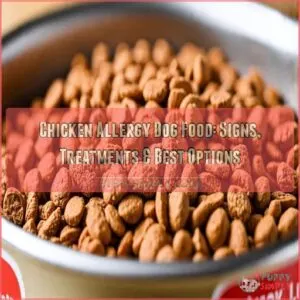This site is supported by our readers. We may earn a commission, at no cost to you, if you purchase through links.

A cherry’s vibrant flesh holds bursts of nutrition, yet its dark center can quickly turn a treat into a trip to the vet. Knowing which parts help and which harm is more than trivia; it’s a matter of keeping your dog safe, energized, and out of harm’s way.
Table Of Contents
- Key Takeaways
- Can Dogs Eat Cherries Safely?
- Dangers of Cherries for Dogs
- Symptoms of Cherry Poisoning in Dogs
- Health Benefits of Cherries for Dogs
- How to Prepare Cherries for Dogs
- Safe Ways to Feed Dogs Cherries
- Alternatives to Cherries for Dogs
- Puppy and Small Dog Precautions
- When to Consult Your Veterinarian
- Frequently Asked Questions (FAQs)
- Are cherries okay for puppies to eat?
- What are symptoms of an allergic reaction to cherries in dogs?
- Can dogs eat dried cherries or cherry products?
- How long after eating cherries do symptoms of poisoning appear?
- Are wild cherries safe for dogs to eat?
- Are cherry blossoms or cherry trees harmful to dogs?
- Can dogs be allergic to cherries?
- Is cherry juice safe for dogs to drink?
- What should I do if my dog eats a whole cherry?
- Conclusion
Key Takeaways
- Cherry pits, stems, and leaves are toxic for dogs because they contain compounds that release cyanide when chewed or digested.
- Eating whole cherries can cause choking or dangerous intestinal blockages, especially in puppies and small dogs.
- Only the fleshy part of the cherry, with the pit, stem, and leaves fully removed, is safe for dogs and should be served in small quantities.
- Signs of cherry poisoning in dogs—like vomiting, labored breathing, and bright red gums—require immediate attention from a veterinarian.
Can Dogs Eat Cherries Safely?
You might wonder if cherries are safe for your dog, and the answer isn’t a simple yes or no. The flesh itself isn’t toxic, but other parts of the cherry pose serious risks.
Let’s look at which parts are dangerous, what can go wrong, and how much is too much.
Which Cherry Parts Are Toxic
The cherry pit contains amygdalin, a toxic compound that releases cyanide when your dog chews or breaks it open. Stems and leaves also carry these cyanogenic glycosides, with cyanide levels highest in seeds and leaves. Even cherry blossoms pose dangers, though they’re less concentrated.
The flesh itself is safe—it’s the pit chewing and stem toxicity that create real risk of cyanide poisoning.
Cherries can also be a healthy snack if prepared correctly.
Risks of Feeding Cherries to Dogs
Beyond the pit itself, feeding cherries comes with three main hazards: the real threat of cyanide poisoning, the physical danger of blockages and choking, and the less obvious risk of excess sugar.
- Cyanide toxicity from cherry pits can cause rapid breathing and weakness
- Intestinal obstruction occurs when whole cherries or pits get lodged in your dog’s digestive tract
- Choking hazard poses immediate danger, especially for smaller breeds
- Sugar overload can trigger upset stomach and contribute to dental problems over time
Recommended Cherry Serving Size
If you do decide to offer cherries, keep portions small—usually one or two pitted cherries for a medium-sized dog, and even less for smaller breeds. Dog size matters when calculating a safe serving size.
Remember that all treats combined should make up no more than 10% of your dog’s daily calorie intake. Feed cherries occasionally, not daily, and watch your dog’s stool for any changes after introducing this fruit.
Dangers of Cherries for Dogs
While cherries can offer nutritional benefits, they also pose serious risks that every dog owner needs to understand. The pits, stems, and leaves contain toxic compounds, and even the flesh itself can cause problems if not prepared correctly.
Let’s look at the three main dangers you should watch for.
Cyanide Poisoning From Pits, Stems, and Leaves
The real danger lurks in what you can’t see. Cherry pits, stems, and leaves contain amygdalin, a compound that releases cyanide when your dog chews or digests them. This cyanide mechanism blocks oxygen from reaching cells, causing rapid onset symptoms of cyanide poisoning like bright red gums, labored breathing, and weakness.
While lethal dosage varies by breed sensitivity, even small amounts demand rapid intervention. Smaller dogs face heightened risk from cyanide toxicity. Ingesting cherry pits can lead to intestinal blockage, requiring veterinary intervention.
Intestinal Blockages and Choking Hazards
Even after you’ve removed the toxic parts, cherry pits can cause serious physical harm if your dog swallows them whole. The pit size relative to your dog’s digestive tract determines blockage severity. Smaller breeds face greater breed susceptibility to intestinal obstruction, which can prevent food from passing through. This creates a choking hazard and potential intestinal blockages requiring emergency surgery.
Prevention tips include always pitting cherries completely and seeking immediate veterinary advice if your dog swallows a pit.
High Sugar Content Risks
Beyond the dangers of pits and blockages, cherries pack enough natural sugar to upset your dog’s stomach or, over time, contribute to weight gain and metabolic problems.
High sugar content can cause energy spikes followed by crashes, and repeated exposure increases obesity concerns and diabetes risk.
The sugar also promotes tooth decay and dental problems, making moderation essential for your dog’s long-term health.
Symptoms of Cherry Poisoning in Dogs
If your dog eats cherry pits, stems, or leaves, you need to know what warning signs to watch for. Cyanide poisoning can develop quickly, and the symptoms range from mild stomach upset to life-threatening emergencies.
Here’s what to look for and when to act fast.
Early Warning Signs (Vomiting, Appetite Loss)
If your dog suddenly turns up his nose at dinner or starts vomiting after sneaking cherries from the counter, don’t brush it off—these subtle shifts can signal the beginning of cyanide poisoning.
Cherry ingestion can quickly lead to vomiting, decreased appetite, and dehydration risks if left unchecked. Monitor frequency and intensity of these symptoms closely—even mild changes warrant immediate attention from your vet.
Advanced Symptoms (Labored Breathing, Seizures)
When cyanide begins overwhelming your dog’s system, the body’s distress signals shift from subtle to severe—labored breathing, bright red gums, and dilated pupils emerge as critical red flags that demand immediate action.
These symptoms of cherry poisoning escalate rapidly—breathing difficulty and gum color changes appear within 30 minutes, followed by seizure signs, lethargy, and collapse risk if emergency treatment is delayed. Cyanide poisoning progresses fast, so recognizing these late warning signs could save your dog’s life.
When to Seek Emergency Help
Time is everything when symptoms of cherry poisoning appear. You need to act immediately if your dog shows signs of distress after eating cherries—the response window for emergency treatment is narrow, and hesitation can turn a treatable situation into a tragedy.
When a dog shows distress after eating cherries, every second counts—act fast, as swift action can save their life
Contact the Pet Poison Helpline (855-764-7661) or your emergency vet right away if you notice:
- Sudden breathing difficulty, bright red gums, or dilated pupils—cyanide symptoms requiring urgent care
- Multiple whole cherries consumed with pits or stems—ingestion quantity matters for toxicity risk
- Repeated vomiting or no bowel movements for over 12 hours—potential blockage signs
- Seizures, severe lethargy, or collapse—emergency care needed regardless of amount eaten
Veterinary protocols emphasize immediate intervention within the first hour for best outcomes.
Health Benefits of Cherries for Dogs
When prepared correctly, cherries can offer your dog some nutritional perks. They’re packed with vitamins, antioxidants, and other compounds that support overall health.
Let’s look at the specific benefits these bright red fruits can provide when served safely.
Antioxidants and Immune Support
Cherries pack antioxidants like anthocyanins and vitamin C that can support your dog’s immune health. These compounds help your dog’s body fight cellular damage and may reduce inflammation in tissues and joints.
The antioxidant benefits strengthen immune function naturally, though cherries should complement—not replace—a balanced diet. When prepared safely, cherries offer real nutritional advantages as an occasional immune boost for your pet.
Vitamins, Fiber, and Hydration
Beyond immune support, cherries deliver essential nutrients that help your dog’s body function at its best. The nutritional value includes:
- Vitamin C for tissue repair and immune function
- Potassium supporting heart and muscle health
- Vitamin A promoting eye and skin wellness
- Fiber aiding digestion and gut health
- High water content providing a hydration boost
These elements support nutrient absorption when cherries complement a balanced diet, though they work best as occasional treats rather than daily staples.
Anti-Inflammatory Properties
For dogs with joint discomfort or inflammation-related conditions, the natural anti-inflammatory compounds in cherries might offer some relief. Anthocyanins combat oxidative stress and reduce inflammation markers that contribute to arthritis symptoms. While cherries won’t replace veterinary treatment, they may support mobility and muscle recovery as part of a broader wellness plan.
| Benefit | Active Compound | Target Area |
|---|---|---|
| Joint Pain Relief | Anthocyanins | Joints, Cartilage |
| Arthritis Support | Antioxidants | Inflammation Markers |
| Muscle Recovery | Vitamin C, Polyphenols | Muscles, Tissues |
How to Prepare Cherries for Dogs
If you decide to share cherries with your dog, proper preparation isn’t optional—it’s essential. The steps you take before offering this fruit can mean the difference between a safe snack and a trip to the emergency vet.
Here’s how to prepare cherries the right way.
Removing Pits, Stems, and Leaves
Before you offer your dog a single cherry, you need to strip away every dangerous part—the pit, stem, and leaves all contain compounds that break down into cyanide in your dog’s digestive system.
Here’s how to remove these hazards:
- Twist off stems at the base where they meet the fruit
- Use pit removal tools or a sharp knife to extract cherry pits completely
- Check for leaves clinging to stems and discard them immediately
- Inspect each cherry visually to confirm nothing dangerous remains
This step eliminates choking hazards and prevents cyanide exposure.
Washing and Cutting Cherries Safely
Once the pit is out, rinse each cherry under cool running water to wash away dirt, pesticides, and any lingering debris that could upset your dog’s stomach. Careful portioning, thorough washing, and proper procedure are key to making cherries a safe food for dogs. Next, slice the fruit into bite-sized pieces—think pea-sized for small dogs.
| Step | Purpose | Tip |
|---|---|---|
| Rinse Thoroughly | Pesticide Removal | Use cool running water |
| Slice Small | Cutting Techniques | Avoid large chunks |
| Double Check | Safe Procedure | Remove stems and leaves |
| Portion Out | Safe Cherry Consumption | Stick to small amounts |
Serving Fresh Vs. Processed Cherries
When you’re standing in the grocery aisle, it’s worth knowing that only fresh, whole cherries have a place in your dog’s bowl. Maraschino cherries, canned cherries, and cherry juice often pack added sugar or artificial sweeteners, which can be dangerous.
Stick to fresh cherry prep or plain frozen cherries, and always mind safe serving sizes for dogs with processed cherries off-limits.
Safe Ways to Feed Dogs Cherries
You want your dog to enjoy cherries safely, and there are a few simple tricks to make that possible.
Let’s walk through some easy options you can use at home. Here’s how you can share this treat the right way.
Moderation and Portion Control
Think of cherries like tiny bursts of summer, but even a sweet treat needs limits for your dog’s bowl. Stick to moderation: a safe serving size for most dogs is one or two pitted cherries as an occasional treat.
Always factor these into your dog’s daily treat limits and calorie calculation, and monitor stool for any changes during gradual introduction.
Fresh, Frozen, and Homemade Cherry Treats
There’s something about the cool snap of a frozen cherry treat or the juicy pop of a fresh one that can make snack time a little more special for your dog. Try these twists:
- Frozen cherry bites for a hot day
- Homemade cherry popsicle recipe using plain yogurt
- Dried cherry chews or homemade cherry puree for simple dog treats
Combining Cherries With Other Safe Foods
Pairing cherries with other safe fruits and veggies is a simple way to make your dog’s treat bowl feel like a mini picnic. Think fruity dog salads with blueberries and watermelon, or a cherry yogurt parfait.
Homemade cherry smoothies and cherry-veggie mixes add variety. Balanced cherry pairings keep things fresh, while exploring dog treat recipes lets you discover safe fruit alternatives for dogs.
Alternatives to Cherries for Dogs
If cherries aren’t the best choice for your dog, you still have plenty of safe options.
There are other fruits and even veggies that make great treats. Let’s take a look at a few healthy alternatives you can feel good about sharing.
Dog-Friendly Fruits (Apples, Blueberries, Bananas)
Have you ever noticed how a crisp apple, a handful of blueberries, or a ripe banana can bring out the tail wags in your pup?
Apples offer vitamin C and fiber, blueberries bring antioxidants (perfect for dog health and safety), and bananas add potassium.
Watch portion sizes, though, and be mindful of fruit allergies. These are excellent, safe fruit alternatives for dogs.
Vegetable Treat Options (Carrots, Green Beans)
If you’re looking for snacks that dogs can crunch without worry, carrots and green beans are a safe bet every time. Carrot benefits include fiber and crunch—great for teeth and dog nutrition.
With green bean prep, serve them plain and chopped. Safe veggies like these add treat variety while keeping veggie portions sensible within a balanced dog food diet or dog treats routine.
Commercial Dog Treat Recommendations
Carrots and green beans keep things simple, but the dog treats market is racing ahead with premium options and functional benefits—think joint or dental support treats.
You’ll see more online accessibility and treat customization these days, so it’s easy to tailor treats to your dog food diet.
Market growth also means you can even find cherry-flavored dog treats or creative dog treat recipes.
Puppy and Small Dog Precautions
Speaking of healthy treats, it’s especially important to pay extra attention when sharing any new food with puppies and pint-sized pups. Their small size makes them much more sensitive to Choking Hazards and Cyanide Sensitivity from cherry pits, stems, or leaves. Just one stray pit could lead to an intestinal blockage or worse. Puppies have fragile digestive systems, so even a bit too much natural sugar or fiber may spark digestive concerns. Start with tiny, pit-free pieces and a gradual introduction. Keep their portions small—safe serving sizes for dogs this young might mean just a quarter of a cherry, if any. When in doubt, always reach out for veterinary advice for dogs before adding something new.
- Tiny tummies need extra protection.
- One pit can be a big problem.
- Growing bodies deserve safe, gentle choices.
When to Consult Your Veterinarian
Sometimes cherries don’t agree with every dog, and it’s tough to know when to call for help. Knowing what to watch for makes all the difference for your peace of mind.
Here are the moments when it’s smart to get your veterinarian involved.
Introducing New Foods to Your Dog’s Diet
Before you add something new to your dog’s bowl, it’s smart to pause and think about how the change might affect their health. Gradual introduction is key: start small and watch your dog for reactions. Use the table below as a quick check for safe, healthy new foods.
| Allergy Watch | Portion Sizes | Food Combinations |
|---|---|---|
| Observe symptoms | Keep treats under 10% daily | Avoid mixing rich |
| Itching, GI upset | Use small test pieces | Watch hydration balance |
| Monitor for days | Follow dog nutrition guidelines | Maintain dog diet |
Handling Adverse Reactions and Emergencies
Even with careful introductions, dogs sometimes react badly to cherries. Acting quickly can save lives. Recognizing symptoms like vomiting, bright red gums, or weakness is essential for early treatment for dog poisoning. Call your vet or a pet poison helpline immediately. Keep these steps in mind:
- Remove all cherries and pits.
- Watch for symptoms of cherry poisoning.
- Seek emergency veterinary care fast.
- Monitor your dog’s recovery closely.
Importance of Pet Insurance for Unexpected Issues
When life throws a curveball—like a sudden trip to the vet—having pet insurance can make all the difference for your peace of mind. Emergency coverage helps tackle high treatment costs, especially for breeds prone to issues.
Policy comparisons matter; what fits one dog mightn’t fit another. Consider your budget, your dog’s needs, and seek veterinary advice before choosing.
Frequently Asked Questions (FAQs)
Are cherries okay for puppies to eat?
Much like training wheels on a bike, introducing cherries to puppies calls for caution.
Because of their sensitive digestive systems and higher choking hazard risks, stick to a tiny puppy serving size—and only safe cherry types, gradually, with your veterinarian’s guidance.
What are symptoms of an allergic reaction to cherries in dogs?
Watch for skin reactions like hives or redness, facial swelling, and breathing difficulty after eating cherries.
Digestive upset, such as vomiting or diarrhea, may occur.
Sudden weakness or collapse signals anaphylaxis risk—an emergency food allergy symptom in dogs.
Can dogs eat dried cherries or cherry products?
Dried cherries, cherry juice, cherry pie, and processed cherries or cherry-flavored items aren’t safe for dogs. These products often have added sugar and preservatives.
Cherry-flavored dog treats made specifically for pets are much safer for occasional snacking.
How long after eating cherries do symptoms of poisoning appear?
Don’t assume all dogs react the same—cherry toxicity can hit fast. For most, poisoning symptoms appear within 15 minutes to several hours after ingestion.
Onset timeline varies with toxicity factors, amount ingested, and breed sensitivity.
Are wild cherries safe for dogs to eat?
Wild cherries pose real health risks for dogs due to high cyanide content and wild cherry toxicity. Identification challenges and regional variations make toxic fruit hard to avoid, so safe wild alternatives are best. Preparation differences can’t remove poisoning risks.
Are cherry blossoms or cherry trees harmful to dogs?
Like a wolf in sheep’s clothing, cherry trees and blossoms can quietly harm dogs. Blossom Toxicity, Leaf Ingestion, and Tree Bark all pose health risks—pollen exposure and allergic reactions add to the poisoning risk of cherry toxicity in dogs.
Can dogs be allergic to cherries?
Dogs can be allergic to cherries, just as with other fruits. Allergy symptoms might include itching, swelling, or digestive upset.
Cross-reactivity and breed predisposition can play a role. Diagnosis methods may involve an allergy test; treatment options vary.
Is cherry juice safe for dogs to drink?
Ever wondered if cherry juice offers any benefits for dogs? Due to high sugar content and uncertain preparation, this isn’t a safe hydration source.
Cherry consumption in dogs—juice included—carries more risks than possible gains for dog health and nutrition.
What should I do if my dog eats a whole cherry?
If your dog swallows a whole cherry, assess symptoms like vomiting or labored breathing right away.
Monitor for signs of cyanide poisoning or intestinal obstruction.
Don’t induce vomiting unless instructed—seek a veterinarian to guarantee safe, preventative measures.
Conclusion
Life’s not always a bowl of cherries for dogs—sometimes, it’s a pitfall. Being curious about “can dogs eat cherries” means you care enough to look out for your best friend.
The sweet flesh might tempt, but the hidden dangers remind you to weigh every treat. By learning the signs, preparing cherries safely, and considering safer alternatives, you become their guardian against hidden hazards.
Knowledge, in this case, truly protects what matters most—your dog’s health and happiness.
- https://www.purina.com/articles/dog/feeding/can-dogs-eat/cherries
- https://www.metlifepetinsurance.com/blog/pet-health/can-dogs-eat-cherries/
- https://www.rover.com/blog/can-dogs-eat-cherries/
- https://www.houndsy.com/blogs/pupdiet/can-dogs-eat-cherries-understanding-the-risks-and-benefits
- https://www.akc.org/expert-advice/nutrition/can-dogs-have-cherries/
















